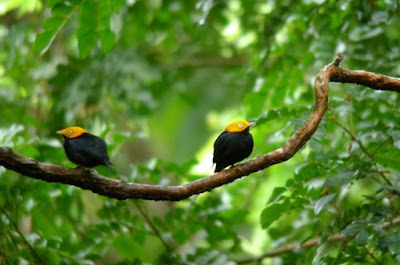Winter and early spring are the seasons when most other tourists go to T & T also. Partly they go in winter to escape the cold weather up north. But another factor is that the other half of the year, June through November, is what used to be referred to as Trinidad’s rainy season.
I say "used to be" because we’ve changed it. That half of the year is now known as the "Green Season."
Yeah, there’s some rain. But we just spent eight very full days in T & T at the peak of the Green Season, and rain was never an inconvenience for us. We carried rain jackets, we carried plastic bags for the cameras and binoculars, and we used common sense about watching the sky. Showers came a couple of times a day but they were brief, and then the skies cleared again. We didn’t lose more than a few minutes to rain, and in between, the birding was fantastic.
I’ve already written about our extraordinary night with the leatherback sea turtles. That’s an experience you won’t have in winter, because the turtles aren’t breeding then. In a more directly bird-related vein, the Green Season also has a lot of breeding bird activity. The total number of species present may be lower than in mid-winter, but the resident tropical birds are highly active and visible. We saw plenty of evidence of that during our visit.

Palm Tanagers were everywhere in T & T, including in the towns. At the Asa Wright Nature Centre, a pair was nesting inside the living room of the main house, and the adults were coming and going without any regard for all the humans on the verandah. We decided that this could be called "Palm Tanager" because it might easily land on the palm of your hand.

This Barred Antshrike nest at the Grafton Estate on Tobago was just one of many nests we found during our trip.

These male Golden-headed Manakins (and 7 or 8 of their buddies) were displaying like mad at a "lek," or communal dancing ground, down one of the trails at Asa Wright. The gaudy males perform little moonwalks and other dances while making buzzing and trilling notes, all to attract females. Which suggests to me that those female manakins must have really weird tastes!

Over on the Main Ridge on Tobago, the male Blue-backed Manakins were similarly preoccupied with doing freaky dances and making strange noises.

Some of the most interesting breeding behavior that we saw involved Common Potoos on the grounds of the Asa Wright Nature Centre. Potoos are genuinely bizarre creatures. Distantly related to nighthawks and Whip-poor-wills, but classified in a different family, potoos spend the day perched bolt upright on high tree branches, looking for all the world like dead stubs. At night, they fly around catching large insects in flight. The naturalists at Asa Wright had located a potoo nest, which really just consisted of a depression on a high branch where the female would have laid her single egg a few weeks earlier. The poor blurry photo above shows an adult potoo brooding the young bird. If it's hard to see what's going on, the next couple of photos should help.  Here's a photo taken a couple of days later, when the adult was roosting atop a different perch. Even here, it doesn't really look like a bird. It's facing toward us, and its very short, broad bill is pointing up toward the left.
Here's a photo taken a couple of days later, when the adult was roosting atop a different perch. Even here, it doesn't really look like a bird. It's facing toward us, and its very short, broad bill is pointing up toward the left.

And here's the young Common Potoo by itself, still perched on the spot where it had hatched. Its bill is pointing up toward the right, and its eyes are closed. Good camouflage, isn't it? It doesn't really look like a dead stub of a branch -- it looks more like a discarded pale teddy bear, plucked from the trash can and tossed up into the tree -- but it doesn't look very edible. Predators aren't likely to go for it.

Here the young potoo has lowered its head a little, its bill is pointing toward the right, and its eye is slightly open. See the eye? (It's under that impressive bushy eyebrow.) Does the shape of the bird make sense now?

Here the little tyke is more thoroughly hunched down. Possibly because it senses that it's just about to start raining. Um, I mean, greening. This isn't the rainy season, it's the Green Season!

Here's Kim (just right of center), surrounded by a group of students and their teachers, showing them the baby Common Potoo through our digiscoping setup. We saw several groups of students during the time we were at Asa Wright, and it was inspiring to see the amount of educational programming that was going on at that fine nature center.
Incidentally, anyone who wants to visit Asa Wright Nature Centre, or explore nature anywhere in Trinidad and Tobago, should contact Caligo Ventures. They are THE experts on birding and natural history in T & T, and they're the exclusive agents for Asa Wright in the USA. Mark Hedden from Caligo traveled with us in T & T, and he proved to be a very impressive guy in terms of his dedication to birding, conservation, and quality travel.






0 komentar:
Post a Comment